
Syzygium luehmannii is a medium-sized coastal rainforest tree native to Australia. Common names include riberry, small leaved lilly pilly, cherry satinash, cherry alder, or clove lilli pilli.
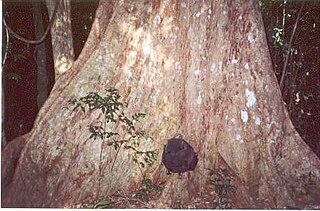
Syzygium francisii is a native Australian tree, common on the eastern sea board, between Morisset, New South Wales and Gladstone, Queensland. Common names include giant water gum, rose satinash, and Francis water gum. The habitat of Syzygium francisii is rainforest on basaltic or fertile alluvial soils.

Pararchidendron pruinosum is an Australian rainforest tree growing from the Shoalhaven River in New South Wales to Herberton in north Queensland. It is also found in New Guinea and Indonesia. Common names include Snow-wood, Tulip Siris and Monkey's Earrings. The habitat of the Snow-wood is tropical, sub-tropical, warm temperate, littoral and riverine rainforest. Like most legume species, it fixes atmospheric nitrogen in the soil via its symbiotic partnership with root bacteria - trading the bacteria starches in exchange for nitrogen. It can be seen growing on sand within earshot of Seven Mile Beach, New South Wales.
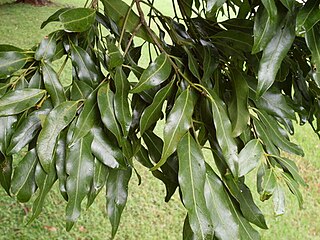
Cinnamomum oliveri is a rainforest tree growing at the eastern coastal parts of Australia. It grows from the Illawarra district in New South Wales to Cape York Peninsula at the northern tip of Australia. The southernmost limit of natural distribution is on the volcanic cliffs above the town of Gerroa and nearby on the sand in rainforest behind Seven Mile Beach, New South Wales.

Cryptocarya obovata is a large laurel growing on basaltic and fertile alluvial soils in eastern Australian rainforests. It is found from Wyong in New South Wales to Gympie in the state of Queensland. Extinct in the Illawarra region, allegedly seen in the Illawarra in 1818 by Allan Cunningham. The species was included in the Prodromus Florae Novae Hollandiae et Insulae Van Diemen, 402 (1810)

Vitex lignum-vitae, known in Australia as yellow hollywood or "lignum-vitae", is a rainforest tree of eastern Australia. The natural range of distribution is in dry, sub-tropical or tropical rainforest from the Richmond River, New South Wales to Cape York Peninsula at the northernmost tip of Australia. It also occurs in New Guinea.

Rhodosphaera is a genus of plants in the family Anacardiaceae. The genus includes a single species, Rhodosphaera rhodanthema, which is a rainforest tree of eastern Australia. It grows in sub tropical rainforests and also in the drier form of rainforests. The natural range of distribution is from the Macleay River, New South Wales to Maryborough in south east Queensland. Common names include deep yellowwood, yellow cedar and tulip satinwood.
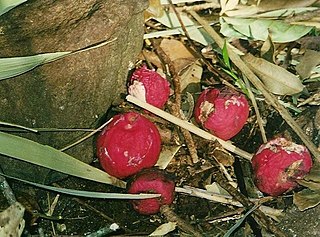
Acmena ingens is a rainforest tree of eastern Australia. It grows on volcanic soil from the Big Scrub region of north eastern New South Wales to Gympie in south eastern Queensland. Known as the red apple or southern satinash, Acmena ingens is one of many fleshy fruited myrtles in Australian rainforests, often referred to as lilli pillies.

Syzygium hodgkinsoniae is a rare subtropical rainforest tree, growing on alluvial soils by streams in the north east New South Wales and south east Queensland, Australia. The range of natural distribution is from the Richmond River, New South Wales to Gympie in south east Queensland. Common names include smooth-bark rose apple or red lilly pilly.

Macaranga tanarius is a plant found in South East Asia, Thailand, Papua New Guinea, Taiwan, and eastern Australia. It is commonly seen as a pioneer species in disturbed rainforest areas. Easily recognised for the round veiny leaves. In Australia it naturally occurs from the Richmond River, New South Wales to Cooktown in tropical Queensland.

Cryptocarya laevigata, known as the glossy laurel or red-fruited laurel, is a rainforest plant growing in eastern Australia. The natural range of distribution is rainforest understorey on fertile soils, from the Richmond River, New South Wales to Cairns in tropical Queensland. Often seen in association with the White Booyong.

Cryptocarya foveolata, known as the mountain walnut is a rainforest tree growing at high altitude in eastern Australia. Despite the common name, it belongs to the laurel family.

Backhousia leptopetala is a common Australian tree, growing from Stanwell Park in the northern Illawarra district to near Buderim in south eastern Queensland.

Elattostachys nervosa, known as the green tamarind or beetroot tree is a common rainforest tree of eastern Australia. Found in all types of rainforest, growing from Paterson, New South Wales in the south to Gympie in south east Queensland. The name Elattostachys refers to "little spikes", a flower feature of other plants in this genus. Nervosa refers to the prominent leaf venation. Beetroot Tree refers to the beetroot red leaves of the new growth.

Cryptocarya bidwillii, the yellow laurel, is a small to medium-sized tree in the laurel family. Occurring in Australian rainforests from Nymboida in the state of New South Wales to Townsville in tropical Queensland. Often found in the dryer ridges in dry rainforest or in viney scrubs.
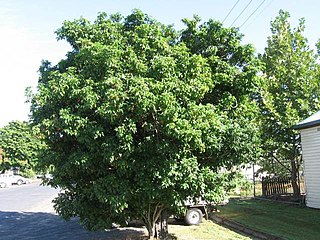
Harpullia pendula, known as the tulipwood or tulip lancewood is a small to medium-sized rainforest tree from Australia. The tree's small size, pleasant form and attractive fruit ensures the popularity of this ornamental tree. The range of natural distribution is from the Bellinger River in northern New South Wales to Coen in tropical Queensland. Tulipwood occurs in various types of rainforest, by streams or dry rainforests on basaltic or alluvial soils. In tropical and sub tropical rainforest. Often seen as a street tree, such as at St Ives, New South Wales.

Gossia acmenoides, known as the scrub ironwood, is a rainforest tree of the family Myrtaceae, native to eastern Australia. The usual habitat of this small tree is drier rainforest areas. The range of natural distribution is from Jamberoo in New South Wales to Eungella National Park in northern Queensland.
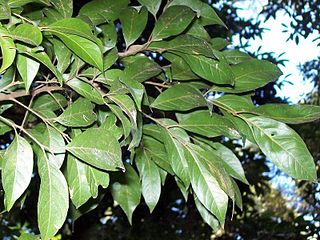
Sarcopteryx stipata, known as the steelwood, is a rainforest tree of eastern Australia occurring from the Bulga Plateau and Comboyne Plateau north west of Taree, New South Wales as far north as Fraser Island off the coast of south eastern Queensland. It grows in sub tropical rainforest but sometimes occurs in warm temperate rainforests on poorer soils. It is a member of the soap berry family. The generic name Sarcopteryx translates to "fleshy wing", as the fruit can be wing shaped. Stipata means "surrounded". The common name steelwood refers to the very tough, hard and heavy timber.

Endiandra introrsa is a rare rainforest tree growing in eastern Australia. Listed with a Rare or Threatened Australian Plants (ROTAP) rating of 3RCa. Its habitat is warm temperate rainforest on the poorer rainforest soils, mostly over 300 metres in altitude, and its range of natural distribution is from near Dorrigo to various sites in the state of Queensland.

Decaspermum humile, commonly known as the silky myrtle, is a tree from Australia and Asia. It can be used as bush food, as indicated by the alternate common name of currant myrtle. The tree features an attractive dark glossy crown. The new pink leaves with silvery hairs are particularly appealing.




















